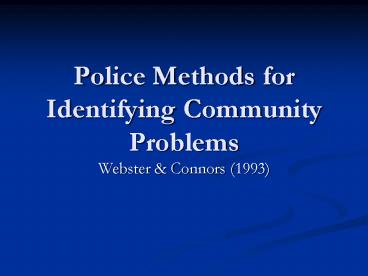Police Methods for Identifying Community Problems PowerPoint PPT Presentation
1 / 16
Title: Police Methods for Identifying Community Problems
1
Police Methods for Identifying Community Problems
- Webster Connors (1993)
2
Community-Oriented Policing
- Lots of interest among police chiefs
- Little knowledge, though
- 80 reported needing assistance or research on
the subject - 69 report interest in apply problem solving
techniques specifically to drug problems
3
COP v. POP
- Commonalities
- Recognize need to draw community police closer
- Consultations between police residents
- Development of strategies to fit neighborhood
needs - Mobilization of community resources
- But, Community Policing encourages a higher level
of community problem identification analysis - Fine tuning of an existing COP program
- A specific enhancement to COP
4
Community Policing
- Described as a philosophy and an organizational
strategy - It broadens the police mandate by placing an
increased emphasis on involving the community in
identifying problems and exploring solutions - Problems such as fear of crime, crime prevention,
disorder, neighborhood deterioration - Recognize link between blight and crime
5
Variation in COP
- Common philosophy but varying emphasis
- Portland (OR) partnership, empowerment,
problem solving, accountability, service - Montgomery County (MD) ultimately COP is what
the Dept. and the community agree it to be - Seattle (WA) COP is an operating philosophy
rather than specific tactics - Tempe (AZ) COP is partnership between police
and community to improve the quality of life in
our city by identifying and resolving public
safety concerns
6
What COP Is Not
- Agreement on what COP is not
- Not an attempt to turn police officers into
social workers - Not a return to unprofessionalism, payoffs, and
political manipulation - Not a public relations ploy
- Not limited community relations unit
7
Problem Solving
- 4 steps
- Identification or scanning
- Analysis
- Response
- Assessment
- Researchers voice concern about pinning it down
in ways that might inhibit its continued growth
8
1970s
- Cop has been around since the 1970s
- Many successful programs aiming at identifying
and solving community problems - Foot patrol program in Flint (MI)
- Community policing experiments in Madison (WI),
Edmonton (Canada), Houston (TX), Newark (NJ) - NYC Community Patrol Officer Program (COPE)
- USDOJ has increased its commitment to COP
- BJA finding of programs
- weed and seed
9
Problem Identification
- Officer Attitudes
- Many officers see COP as just another fad
- COP calls on officers to focus on disorder or on
environmental conditions that facilitate crime - This might conflict with their view of the crime
fighter - Other personnel must be convinced of the merits
of COP in order for it to succeed - Personnel who prepare the budget, purchase
equipment, perform crime analysis
10
Departmental Preparation Support
- Other problems can be encountered relating to the
departments preparation for COP - Officers need time to engage in problem
identification solving - Well-staffed lower crime dept.s have no worry
- What about busy dept.?
- COP is at mercy of 911
- An absence of rewards for problem solving may
also inhibit problem identification
11
Ways to Identify Problems
- Officer observation experience
- Excellent way to learn of problems is to listen
to patrol officers recount their experiences - Patrol officers can also identify opportunities
to prevent crime - Patrol officers assigned to neighborhoods have
opportunities to observe neighborhood conditions
12
Crime Analysis
- Minneapolis (MN)
- Found 50 of calls came from 3 of places
- All robbery calls came from 2.2 of places
- All rape calls came from 1.2 of places
- All auto thefts came from 2.7 of places
- Use crime analysis and crime mapping to uncover
crime patterns
13
Community Groups
- Soliciting information from community groups
citizens good way to get them involved in their
own problem solving - Neighborhood Watch
- Cautions
- Their concerns might not reflect those of the
neighborhood as a whole - Group members are not necessarily representative
of those who would be affected by proposed
solutions - Police must be careful not to raise expectations
14
Surveys
- Officers may canvass business proprietors for
information - Officers can telephone businesses
- Officers may survey residents
- Officer surveys can be used to develop beat
profile - Great PR tool
15
Other Information Sources
- TV
- Newspapers
- Letters to the editor
- editorials
- Radio
- Local talk shows
16
Appropriate Problems for Patrol Problem Solving
- Burglaries concentrated in a given area
- Auto thefts from a mall
- Drug activity at a private residence
- Loitering in a given area
- Parking traffic problems
- Prostitution
- Cruising

